Design of a Biomechatronic Device for Upright Mobility in People with SCI Using an Exoskeleton Like a Stabilization System
Abstract
:1. Introduction
2. Materials and Methods
2.1. Design Requirements
2.2. Anthropometry
3. System Design
3.1. Design of the Mechatronic System
3.2. Seated-Standing Mechanism
3.3. Mobility Motor System
3.4. Mobility in an Urban Environment
3.4.1. Horizontal Floor
3.4.2. Sagittal Ramp
3.5. Mathematical Model
3.5.1. Sagittal Stability System
- 1.
- Integrated by the exoskeleton with pendulum movement which is composed of two components: a user of 80 kg and an Exoskeleton of 10 kg.
- 2.
- The center of gravity of the user CGU corresponds to a healthy user according to 50 percentile (average height of Mexican man), with an elevation to of the plant of its feet placed in the footrest of the exoskeleton of elevation to the floor, therefore, the CGU is located to with respect to the ground. The exoskeleton is articulated as a pendulum, coinciding with the location of the CGU. This exoskeleton supports the user in an upright position and covers or dresses him from the CGU to the soles of his feet, perched on the footrest, thus constituting the pendulum elements of the sagittal stability system;
- 3.
- The sagittal and coronal stability systems are designed by requirement protocol and internal validation, to operate in an urban environment, with a maximum inclination of 15°. However, considering the issue of abuse of use by the user identified by FDA, in which the Exoskeleton devices are taken, to operate beyond the capacity for which they were designed, it is decided, to perform the mathematical model for an extreme case of ramp at 20°, as an application of safety factor;
- 4.
- The simplified version mobility device considers only four wheels of r = , supporting 33 kg each one of them;
- 5.
- The Sagittal stability system considers only one degree of freedom or pendulum joint, located in coincidence with the point called CGU;
- 6.
- The Mathematical Model of the sagittal stability system considers, for special attention, the position of the Center of Gravity of the System (CGS) through time. The sagittal stability system considers a weight of the mobility device is equal to 42 kg in bilateral symmetry, with a center of gravity collinear to the CGU and CGS, not represented in Figure 11, but included in the CGS resultant.
3.5.2. Coronal Stability System
- 1.
- Integrated by a parallelogram system constituted by two horizontal bars, articulated at their central point with a vertical pedestal (A, B), on their sides to a left vertical skate (C, D) and a right vertical skate (E, F), for a total of six joints or degrees of freedom. Weight of the system = 42 kg. The joint with the pedestal allows both horizontal bars to turn to the left (CCW) or right (CW) a maximum of 15°, nevertheless, Figure 12 represents the extreme case of 20° as an additional safety factor;
- 2.
- In the complete version of the coronal stability system, each skate has two pairs of line wheels, and each pair of lined wheels is articulated to the skate through a transverse tubular (bearing shaft) mentioned in Figure 12 and Figure 13. The 6E component, which allows swinging every pair of lined wheels a maximum of 45° to the left and right, is a feature that allows traction around the curb of the sidewalk in its up/down movement. As a simplified model, every transverse tubular is considered (bearing axle) as an axle for a single wheel of diameter (r = ); therefore, the mobility device in its simplified scheme has only four wheels without the possibility of a pendulum and—where it stands out—the location of the CGU and CGS remain unchanged. In this simplified model, every wheel supports 33 kg.
- 3.
- Two packs of batteries are considered to be applied to energize the mobility device, located on the back side of each skate (left and right), inside an exclusive container, independent and isolated. Its weight is already considered in the weight of the system (12 kg).
3.5.3. Kinematics
- A—Left front wheel
- B—Right front wheel
- C—Right rear wheel
- D—Left rear wheel
- a—Distance between robot center and front wheels
- b—Distance between robot center and rear wheels
- u—Longitudinal velocity
- v—lateral velocity
- — Yaw Angle
3.6. Drive System Design
3.6.1. Ratio of DC Electric Motor and Wheel Tire
3.6.2. Transmission
3.6.3. Weight
3.6.4. Bearings
4. Results
4.1. Motor Characterization
4.2. Finite Element Analysis
5. Discussion
6. Conclusions
Author Contributions
Funding
Informed Consent Statement
Acknowledgments
Conflicts of Interest
Abbreviations
| SCI | Spinal Cord Injury |
| ASIA | American Spinal Injury Association |
| ADL | Activities of Daily Living |
| DOF | Degree of Freedom |
| CG | Center of gravity |
| DC | Direct Current |
| CCW | Counterclockwise |
| CW | Clockwise |
| CGS | Center of Gravity of the System |
| CNC | Computer Numerical Control |
References
- Karimi, M.T. Evidence-based evaluation of physiological effects of standing and walking in individuals with spinal cord injury. Iran. J. Med. Sci. 2011, 36, 242–253. [Google Scholar] [PubMed]
- Kirshblum, S.C.; Burns, S.P.; Biering-Sorensen, F.; Donovan, W.; Graves, D.E.; Jha, A.; Johansen, M.; Jones, L.; Krassioukov, A.; Mulcahey, M.J.; et al. International standards for neurological classification of spinal cord injury (revised 2011). J. Spinal Cord. Med. 2011, 34, 535–546. [Google Scholar] [CrossRef] [PubMed]
- Ma, Q.; Ji, L.; Wang, R. The Development and Preliminary Test of a Powered Alternately Walking Exoskeleton With the Wheeled Foot for Paraplegic Patients. IEEE Trans. Neural Syst. Rehabil. Eng. Publ. IEEE Eng. Med. Biol. Soc. 2018, 26, 451–459. [Google Scholar] [CrossRef] [PubMed]
- Tiboni, M.; Borboni, A.; Vérité, F.; Bregoli, C.; Amici, C. Sensors and Actuation Technologies in Exoskeletons: A Review. Sensors 2022, 22, 884. [Google Scholar] [CrossRef] [PubMed]
- Lee, L.W.; Li, I.H.; Lu, L.Y.; Hsu, Y.B.; Chiou, S.J.; Su, T.J. Hardware Development and Safety Control Strategy Design for a Mobile Rehabilitation Robot. Appl. Sci. 2022, 12, 5979. [Google Scholar] [CrossRef]
- Tang, X.; Wang, X.; Ji, X.; Zhou, Y.; Yang, J.; Wei, Y.; Zhang, W. A Wearable Lower Limb Exoskeleton: Reducing the Energy Cost of Human Movement. Micromachines 2022, 13, 900. [Google Scholar] [CrossRef] [PubMed]
- Veneman, J.F.; Kruidhof, R.; Hekman, E.E.G.; Ekkelenkamp, R.; Van Asseldonk, E.H.F.; van der Kooij, H. Design and evaluation of the LOPES exoskeleton robot for interactive gait rehabilitation. IEEE Trans. Neural Syst. Rehabil. Eng. Publ. IEEE Eng. Med. Biol. Soc. 2007, 15, 379–386. [Google Scholar] [CrossRef] [PubMed]
- Fattah, A.; Agrawal, S.K.; Catlin, G.; Hamnett, J. Design of a Passive Gravity-Balanced Assistive Device for Sit-to-Stand Tasks. J. Mech. Des. 2005, 128, 1122–1129. [Google Scholar] [CrossRef]
- Low, K.H.; Liu, X.; Goh, C.H.; Yu, H. Locomotive Control of a Wearable Lower Exoskeleton for Walking Enhancement. J. Vib. Control 2006, 12, 1311–1336. [Google Scholar] [CrossRef]
- Onose, G.; Cârdei, V.; Craciunoiu, S.T.; Avramescu, V.; Opris, I.; Lebedev, M.A.; Constantinescu, M.V. Mechatronic Wearable Exoskeletons for Bionic Bipedal Standing and Walking: A New Synthetic Approach. Front. Neurosci. 2016, 10, 343. [Google Scholar] [CrossRef] [PubMed]
- Li, Z.; Xie, H.; Li, W.; Yao, Z. Proceeding of human exoskeleton technology and discussions on future research. Chin. J. Mech. Eng. 2014, 27, 437–447. [Google Scholar] [CrossRef]
- Yepes, J.C.; Rúa, S.; Osorio, M.; Pérez, V.Z.; Moreno, J.A.; Al-Jumaily, A.; Betancur, M.J. Human-Robot Interaction Torque Estimation Methods for a Lower Limb Rehabilitation Robotic System with Uncertainties. Appl. Sci. 2022, 12, 5529. [Google Scholar] [CrossRef]
- Hammell, K.R.W. Spinal cord injury rehabilitation research: Patient priorities, current deficiencies and potential directions. Disabil. Rehabil. 2010, 32, 1209–1218. [Google Scholar] [CrossRef] [PubMed]
- Tilley, A.; Dreyfuss, H.; Associates, H.D. The Measure of Man and Woman: Human Factors in Design; Whitney Library of Design: New York, NY, USA, 1993. [Google Scholar]
- Walsh, C.J.; Paluska, D.; Pasch, K.A.; Grand, W.; Valiente, A.; Herr, H.M. Development of a lightweight, underactuated exoskeleton for load-carrying augmentation. In Proceedings of the 2006 IEEE International Conference on Robotics and Automation, ICRA 2006, Orlando, FL, USA, 15–19 May 2006; pp. 3485–3491. [Google Scholar]
- Ferris, D.P.; Sawicki, G.S.; Domingo, A. Powered lower limb orthoses for gait rehabilitation. Top. Spinal Cord. Inj. Rehabil. 2005, 11, 34–49. [Google Scholar] [CrossRef] [PubMed]
- Suzuki, K.; Mito, G.; Kawamoto, H.; Hasegawa, Y.; Sankai, Y. Intention-based walking support for paraplegia patients with Robot Suit HAL. Adv. Robot. 2007, 21, 1441–1469. [Google Scholar] [CrossRef]
- Costa, N.; Caldwell, D.G. Control of a Biomimetic “Soft-actuated” 10DoF Lower Body Exoskeleton. In Proceedings of the First IEEE/RAS-EMBS International Conference on Biomedical Robotics and Biomechatronics, BioRob 2006, Pisa, Italy, 20–22 February 2006; pp. 495–501. [Google Scholar] [CrossRef]
- Banala, S.K.; Agrawal, S.K.; Scholz, J.P. Active Leg Exoskeleton (ALEX) for Gait Rehabilitation of Motor-Impaired Patients. In Proceedings of the 2007 IEEE 10th International Conference on Rehabilitation Robotics, Noordwijk, The Netherlands, 13–15 June 2007; pp. 401–407. [Google Scholar] [CrossRef]
- Marcheschi, S.; Salsedo, F.; Fontana, M.; Bergamasco, M. Body Extender: Whole body exoskeleton for human power augmentation. In Proceedings of the IEEE International Conference on Robotics and Automation, Shanghai, China, 9–13 May 2011; pp. 611–616. [Google Scholar] [CrossRef]
- Tsukahara, A.; Kawanishi, R.; Hasegawa, Y.; Sankai, Y. Sit-to-Stand and Stand-to-Sit Transfer Support for Complete Paraplegic Patients with Robot Suit HAL. Adv. Robot. 2010, 24, 1615–1638. [Google Scholar] [CrossRef]
- Tanabe, S.; Hirano, S.; Saitoh, E. Wearable Power-Assist Locomotor (WPAL) for supporting upright walking in persons with paraplegia. NeuroRehabilitation 2013, 33, 99–106. [Google Scholar] [CrossRef] [PubMed]
- Contreras-Vidal, J.L.; Grossman, R.G. NeuroRex: A clinical neural interface roadmap for EEG-based brain machine interfaces to a lower body robotic exoskeleton. In Proceedings of the 2013 35th Annual International Conference of the IEEE Engineering in Medicine and Biology Society (EMBC), Osaka, Japan, 3–7 July 2013; Volume 2013, pp. 1579–1582. [Google Scholar] [CrossRef]
- Sylos-Labini, F.; La Scaleia, V.; D’Avella, A.; Pisotta, I.; Tamburella, F.; Scivoletto, G.; Molinari, M.; Wang, S.; Wang, L.; van Asseldonk, E.; et al. EMG patterns during assisted walking in the exoskeleton. Front. Hum. Neurosci. 2014, 8, 423. [Google Scholar] [CrossRef] [PubMed]
- Junius, K.; Brackx, B.; Grosu, V.; Cuypers, H.; Geeroms, J.; Moltedo, M.; Vanderborght, B.; Lefeber, D. Mechatronic design of a sit-to-stance exoskeleton. In Proceedings of the 5th IEEE RAS/EMBS International Conference on Biomedical Robotics and Biomechatronics, Sao Paulo, Brazil, 12–15 August 2014; pp. 945–950. [Google Scholar] [CrossRef]
- Collins, S.H.; Wiggin, M.B.; Sawicki, G.S. Reducing the energy cost of human walking using an unpowered exoskeleton. Nature 2015, 522, 212–215. [Google Scholar] [CrossRef] [PubMed]
- Asbeck, A.T.; Dyer, R.J.; Larusson, A.F.; Walsh, C.J. Biologically-inspired soft exosuit. IEEE Int. Conf. Rehabil. Robot. 2013, 2013, 6650455. [Google Scholar] [CrossRef] [PubMed]
- Tarun, D.; Srikanth, V.; Kumar, R.; Anudeep, I.M.; Srikanth, S. Stress Analysis on a Chairless Chair; Research India Publications: Delhi, India, 2017. [Google Scholar]
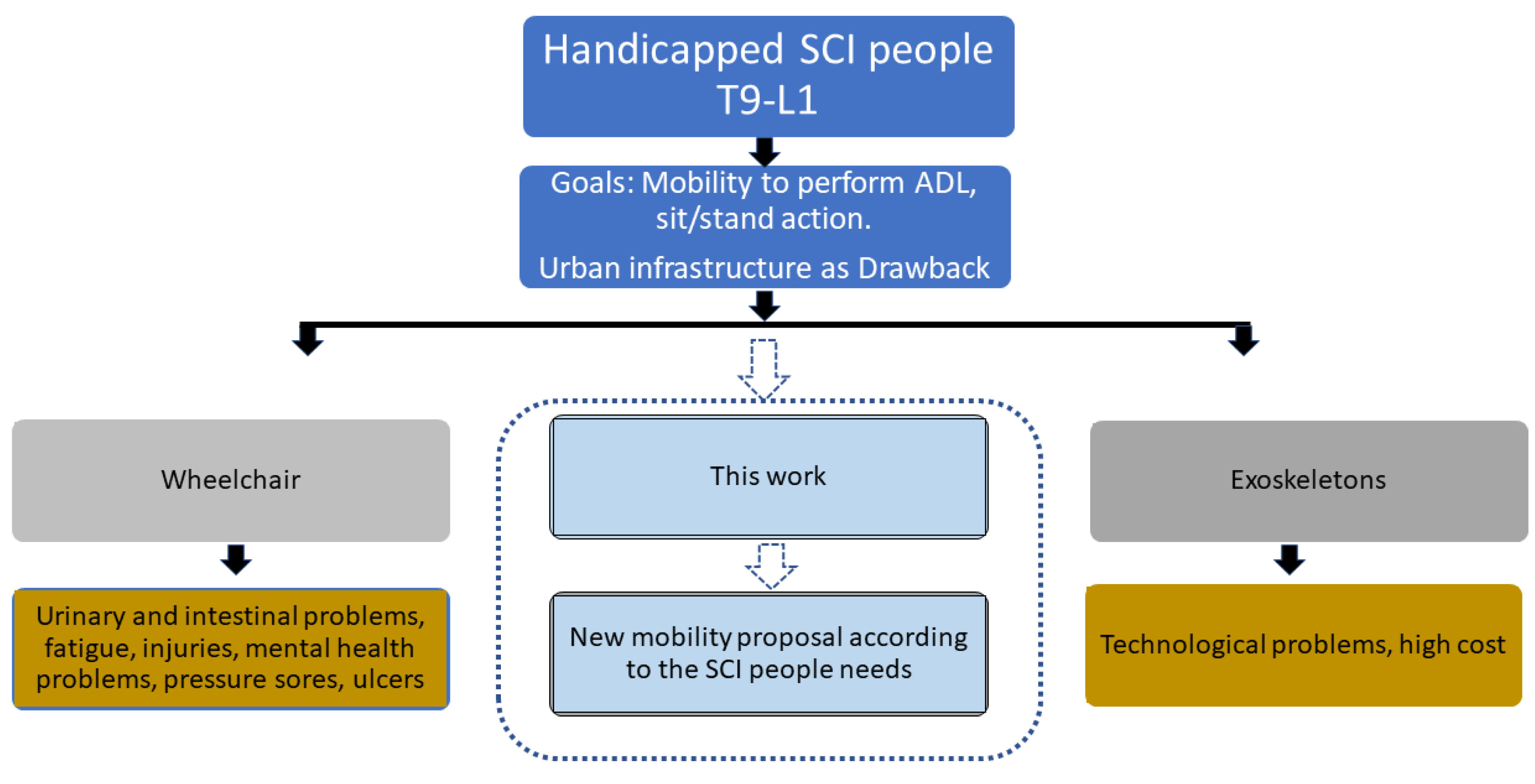

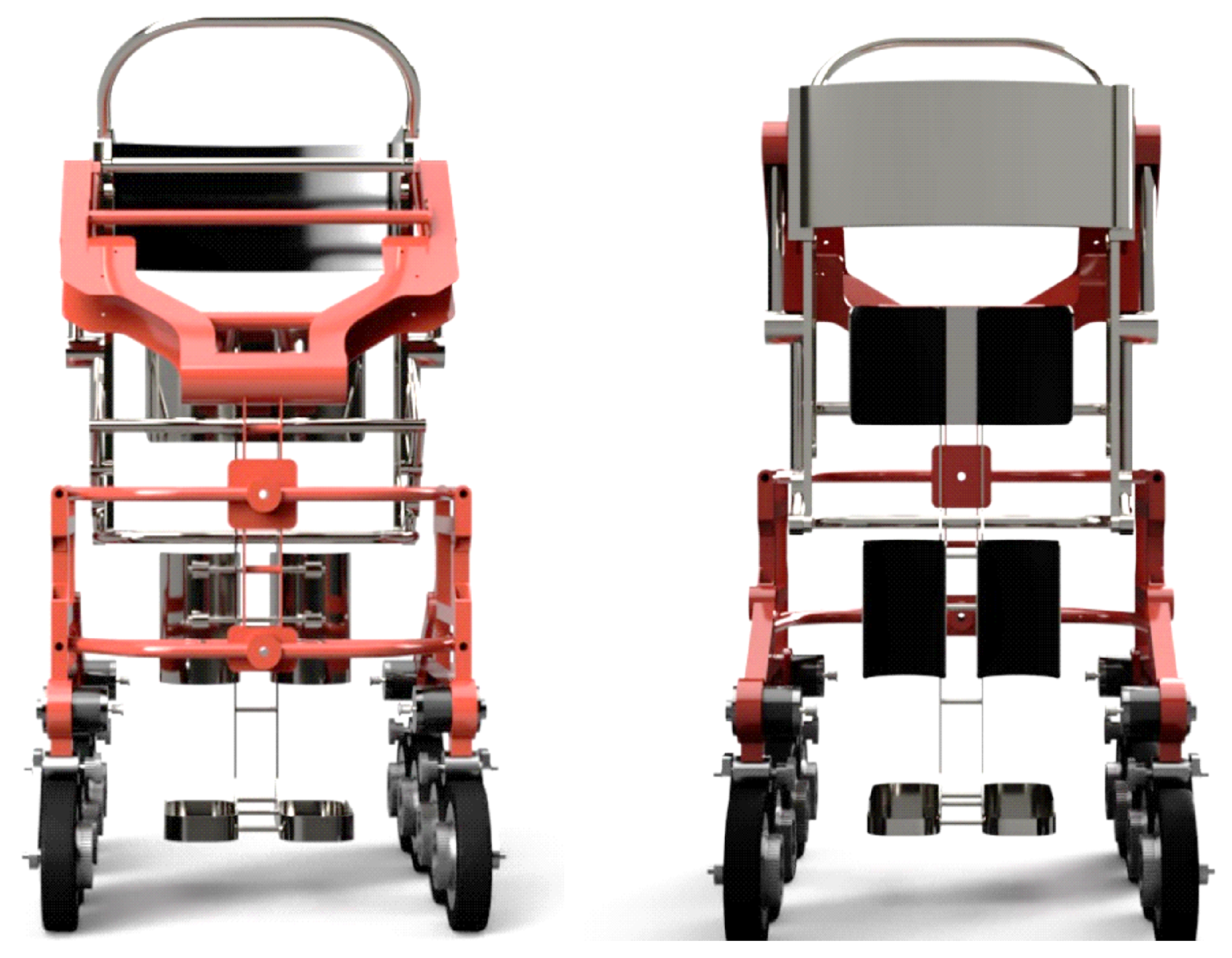

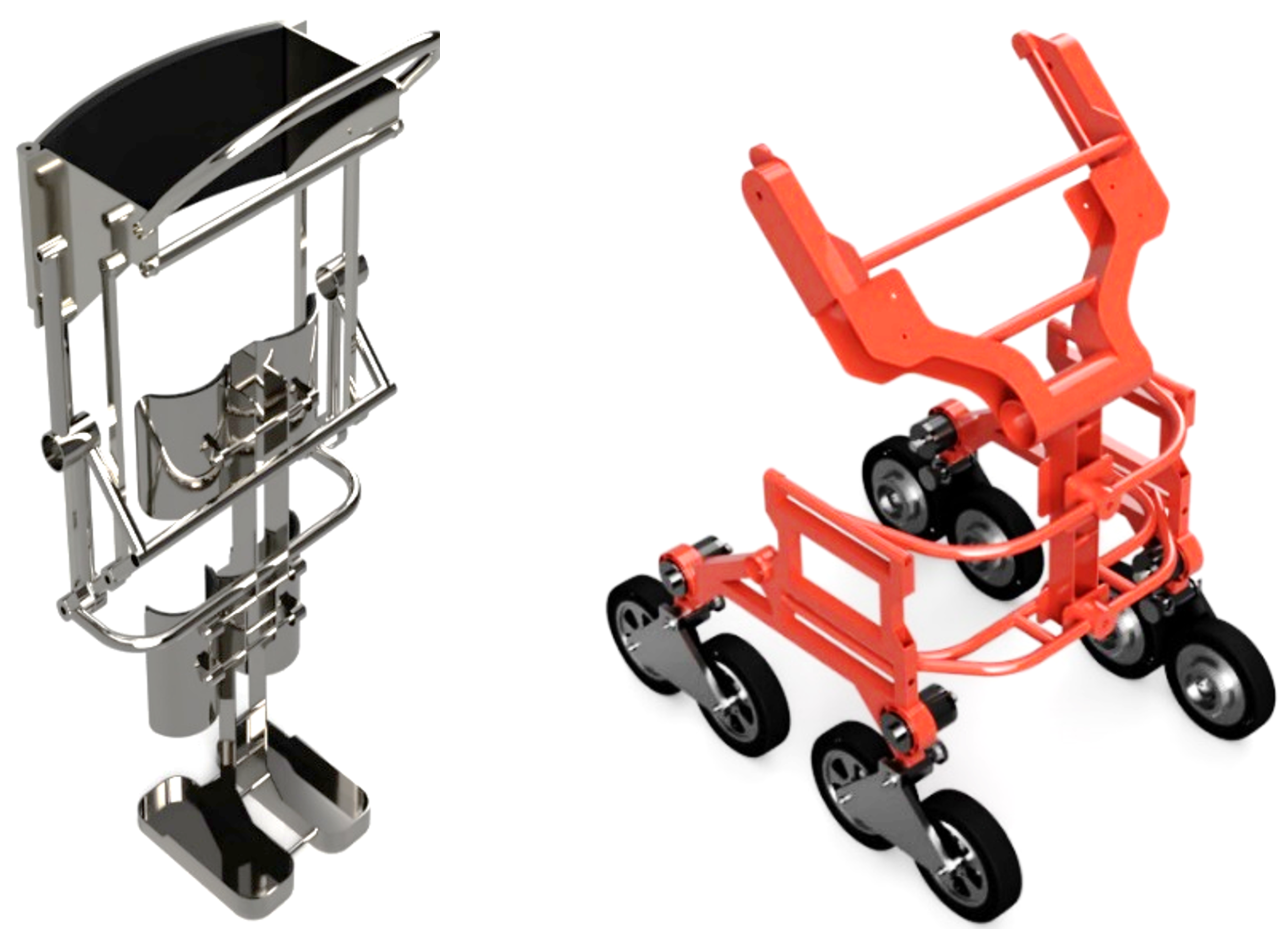
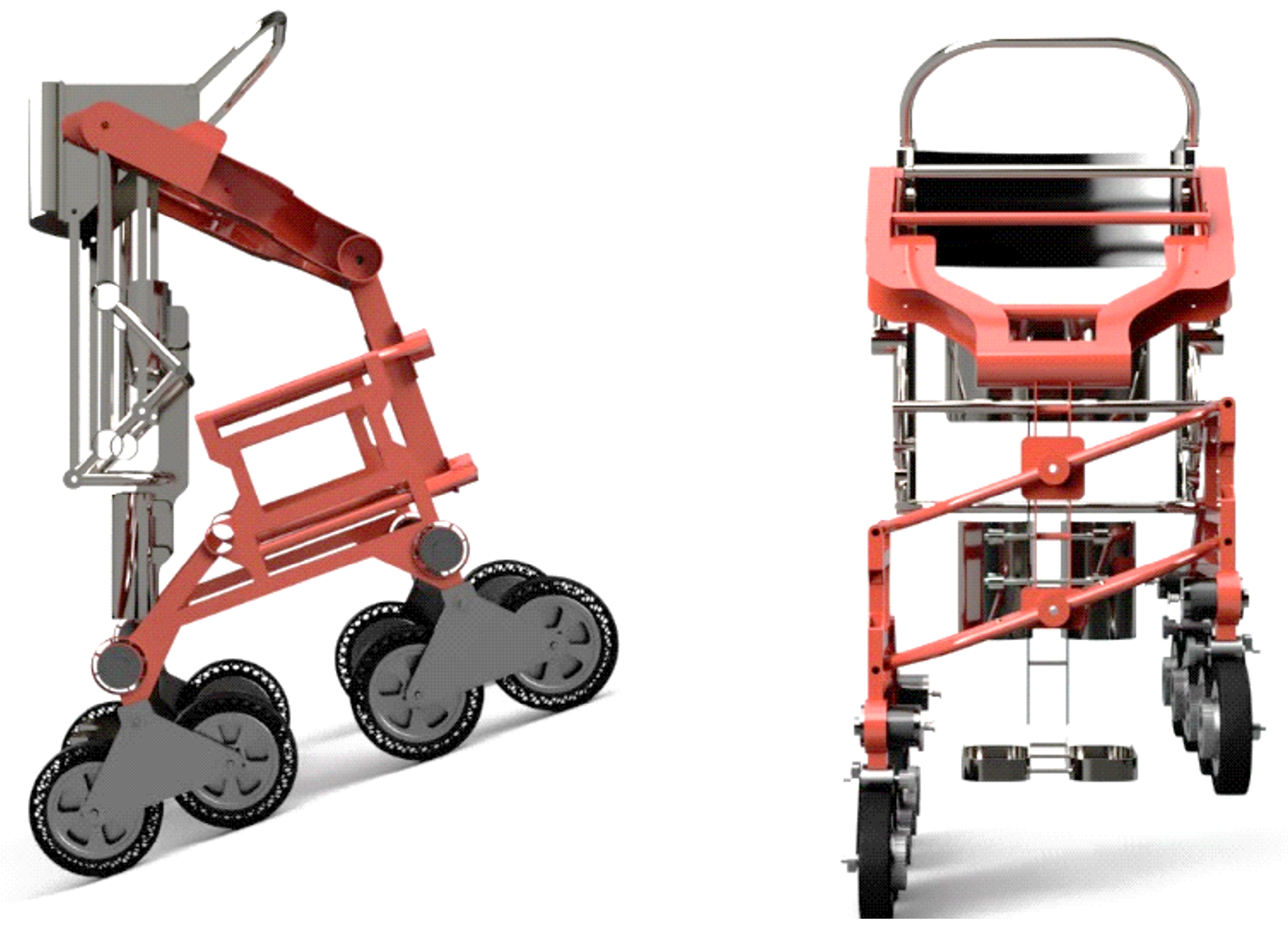
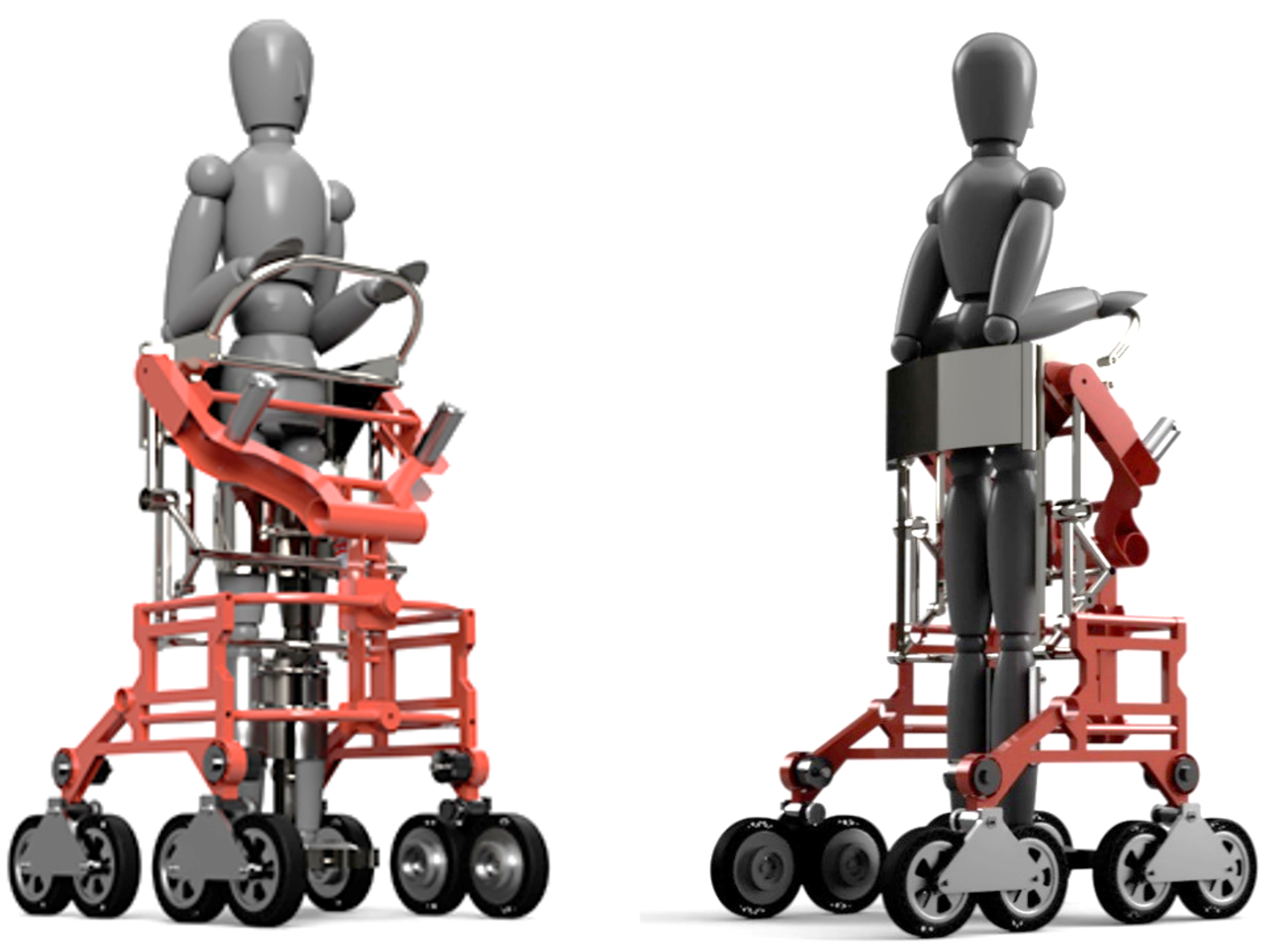
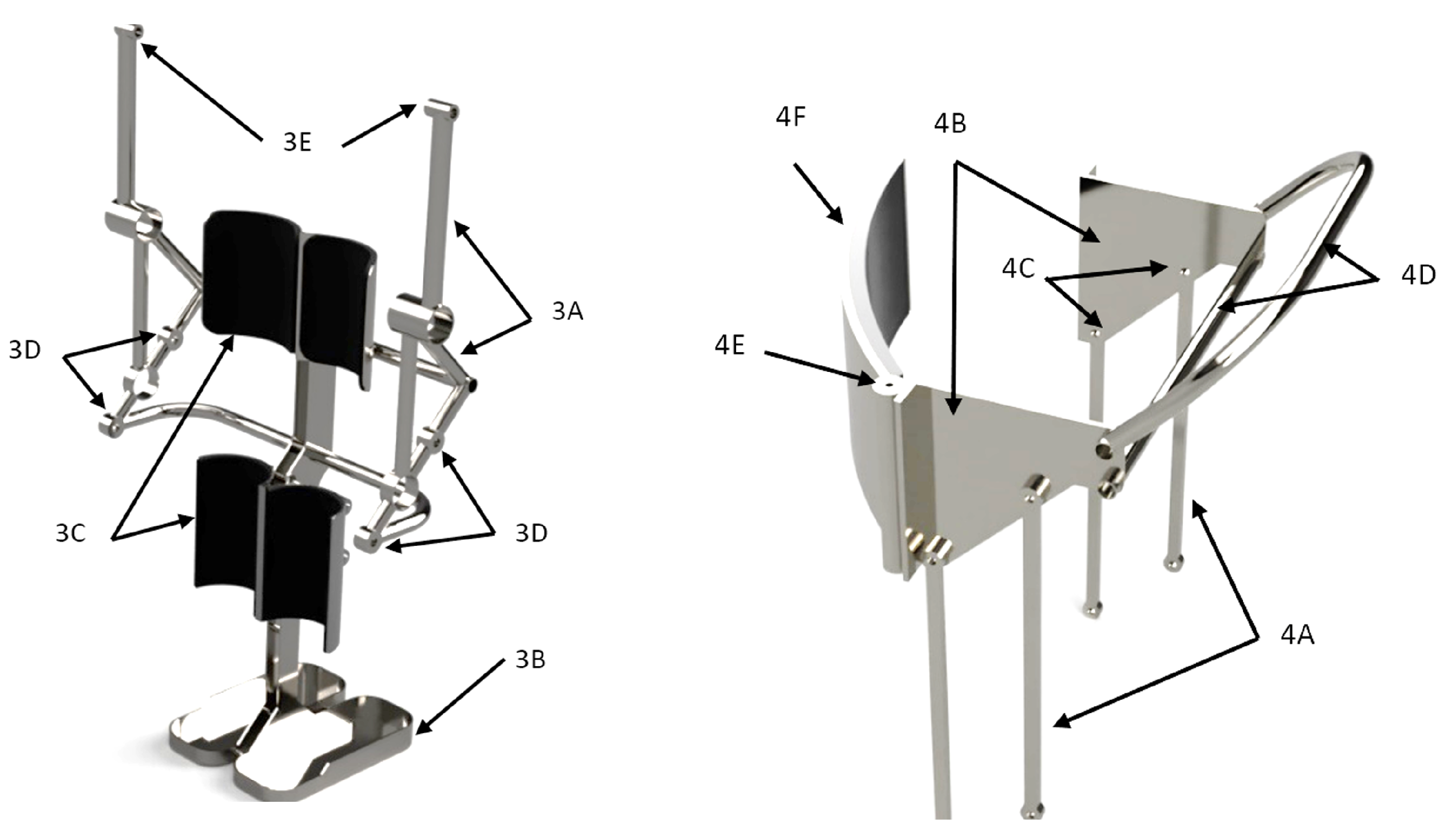
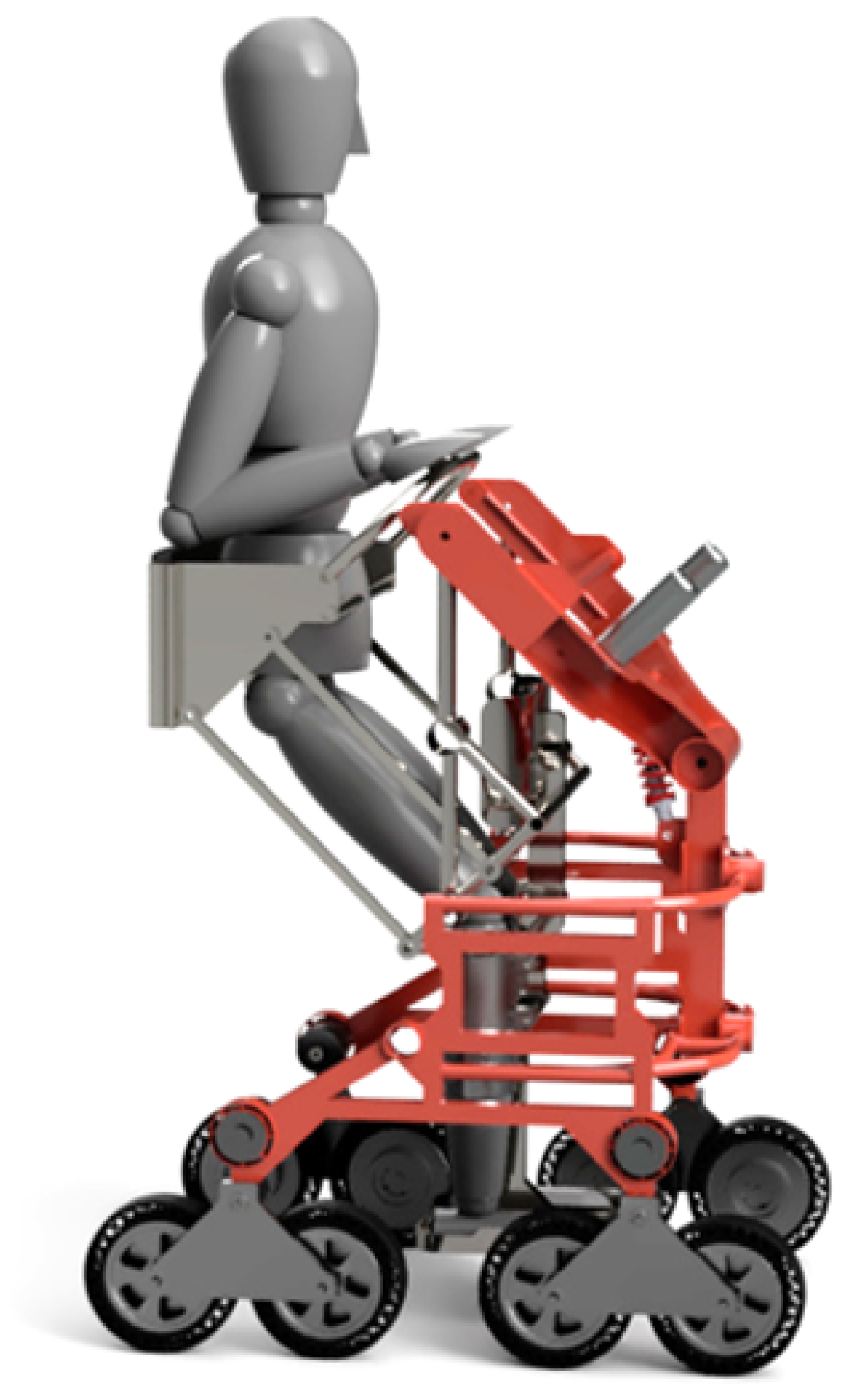



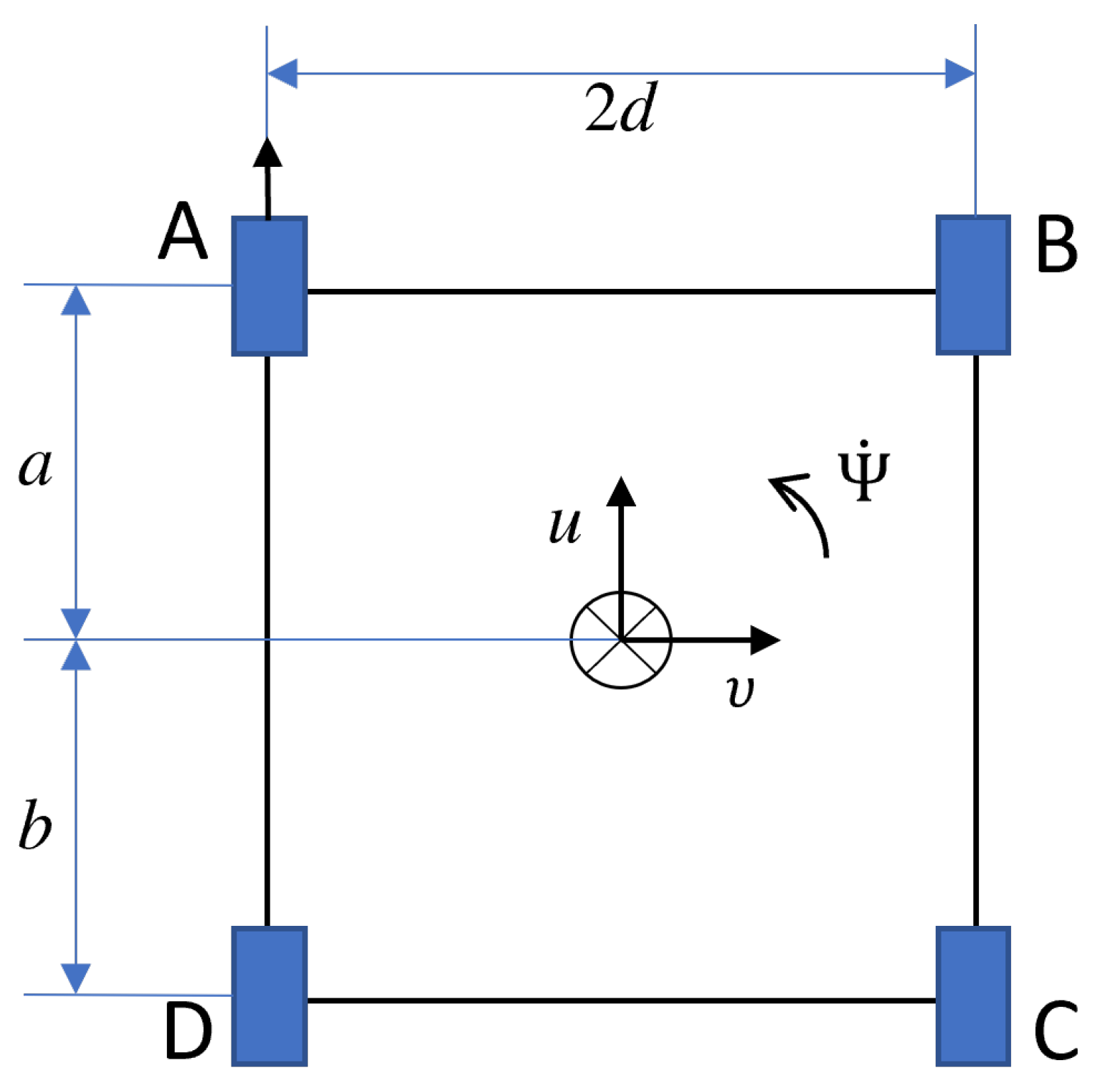
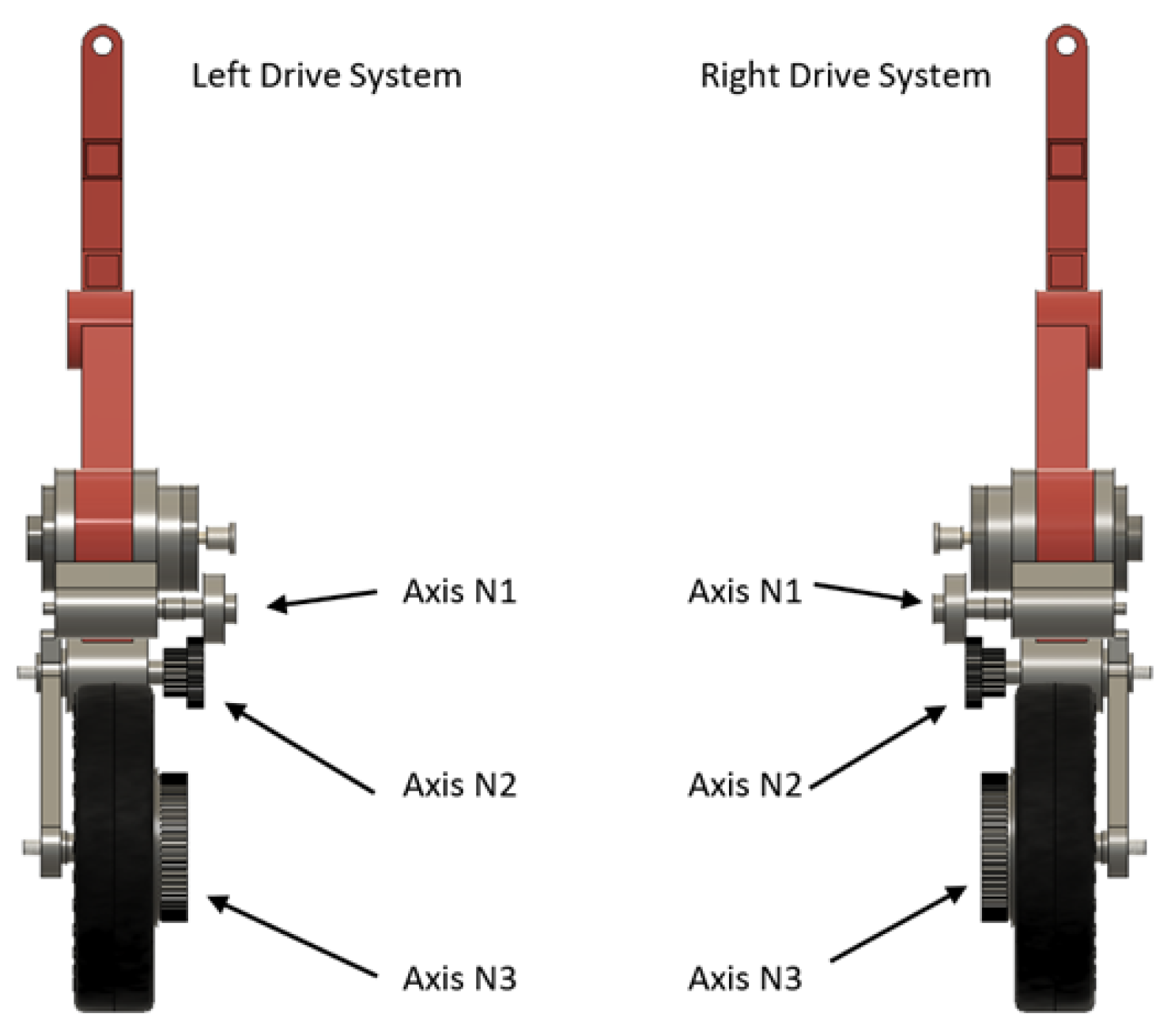

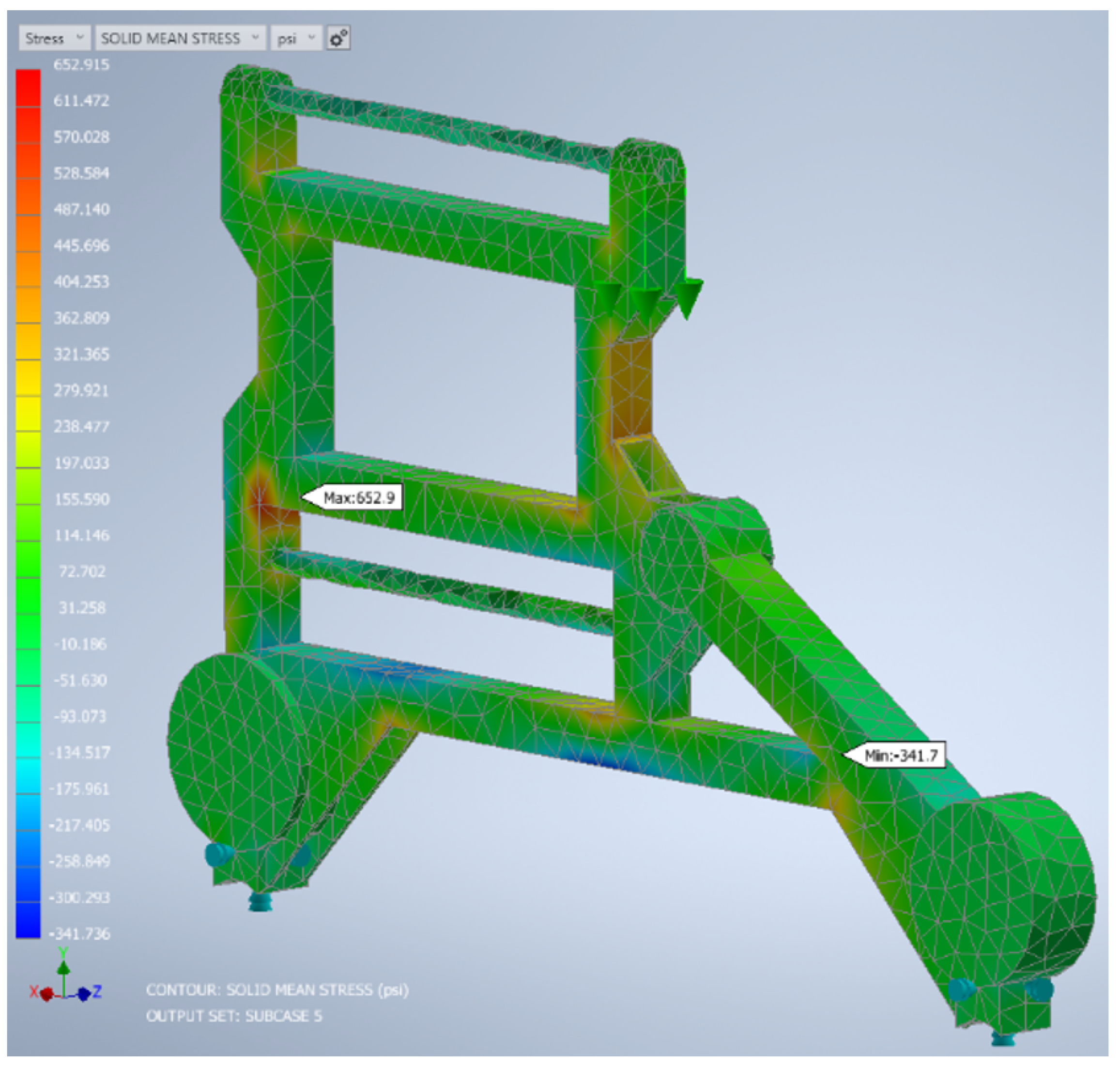

| Activities of Daily Living |
|---|
| Going out to get groceries. |
| Driving or using means of transportation. |
| Preparing meals. |
| Accessing to banks and financial institutions. |
| Cleaning and home chores. |
| Using fixed telephone numbers. |
| Doing laundry. |
| Visiting the doctor. |
| User Requirements |
|---|
|
| Operative Requirements |
|---|
|
| Security Requirements |
|---|
|
| Test | Force (lb) | Speed (rpm) | Current (A) | Power (Watts) | Input (HP) | Torque (lb-ft) | Ang Vel (ft-seg) | Output (HP) | Efficiency |
|---|---|---|---|---|---|---|---|---|---|
| 1 | 0.2 | 3998 | 1.26 | 30.2 | 0.04 | 0.053 | 66.6 | 0.02 | 50 |
| 2 | 0.394 | 3908 | 1.86 | 44.6 | 0.059 | 0.079 | 65.1 | 0.046 | 51 |
| 3 | 0.53 | 3807 | 2.58 | 61.9 | 0.082 | 0.114 | 63.45 | 0.061 | 74.4 |
| 4 | 0.71 | 3706 | 3.25 | 78 | 0.104 | 0.148 | 61.76 | 0.079 | 75.9 |
| 5 | 0.88 | 3620 | 3.77 | 90.4 | 0.121 | 0.175 | 60.33 | 0.096 | 79.3 |
| 6 | 1.06 | 3530 | 4.44 | 106.5 | 0.142 | 0.212 | 58.83 | 0.113 | 79.5 |
| 7 | 1.23 | 3438 | 5.05 | 121.2 | 0.162 | 0.248 | 57.3 | 0.128 | 79 |
| 8 | 1.41 | 3346 | 5.65 | 135.6 | 0.181 | 0.285 | 55.76 | 0.142 | 78.5 |
| 9 | 1.57 | 3264 | 6.32 | 151.6 | 0.203 | 0.327 | 54.4 | 0.155 | 76.4 |
| 10 | 1.75 | 3165 | 6.99 | 167.7 | 0.224 | 0.373 | 52.75 | 0.167 | 74.5 |
| 11 | 1.9 | 3090 | 7.5 | 180 | 0.241 | 0.41 | 51.5 | 0.177 | 73.8 |
| 12 | 2.08 | 3008 | 8.04 | 192.9 | 0.258 | 0.451 | 50.13 | 0.189 | 73.4 |
| 13 | 2.2 | 2929 | 8.55 | 205.2 | 0.275 | 0.493 | 48.81 | 0.195 | 71 |
| 14 | 2.34 | 2847 | 9.01 | 216.2 | 0.289 | 0.534 | 47.45 | 0.201 | 69.5 |
| 15 | 2.52 | 2780 | 9.7 | 232.8 | 0.312 | 0.589 | 46.33 | 0.212 | 67.9 |
| 16 | 2.64 | 2720 | 9.99 | 239.7 | 0.321 | 0.62 | 45.33 | 0.217 | 67.7 |
| 17 | 2.74 | Stall | Stall | Stall | Stall | Stall | Stall | Stall | Stall |
| Name/Ref. | Configuration | Target | Main Contribution |
|---|---|---|---|
| This work | Standing/sitting mobility | Reduced mobility and elderly assistance | Sagittal/coronal stability, standing/sitting mechanism, solved for sloping surfaces, simplicity in the mechanical design, easy manufacturing. |
| [15] | Active hip and knee joints. Passive in the ankle | Reduced mobility and elderly assistance | 15 kg weight, FRF when changing CG when stationary/walking without manual control. |
| [16] | Knee-ankle-foot active orthosis with interconnected steel segments. | Reduced mobility and elderly assistance. | 3 kg weight, automatic ascent/descent handlebars for sitting/standing. |
| HAL-5 [17] | Segmented exoskeleton with hip, knee, and ankle joints. | Adults with total or partial paraplegia. | 15 kg including batteries. No manual control is required for activation. |
| LEE [9] | External and internal EXO. Articulated segments at the hip, knee, and ankle. | Healthy adults. | Not solved for inclines and steps applying load. |
| RGO [18] | 10 DOF, 3 in hip, 1 knee, and 1 ankle, flexible pneumatic muscles in antagonistic pairs. | Adults with partial paraplegia | 17 kg weight. Demonstrated that PMA can be applied to an EXO. |
| LOPEZ [7] | External structure for pelvis support. Hip, knee, and ankle joints | Adults with partial paraplegia, rehabilitation | It can be safely applied for gait training. |
| ALEX [19] | Extension springs in the hip, interconnected segments. | Healthy adults | Increase load capacity by transferring 90% of the weight to the leg structure. |
| EHPA [20] | Full body wraparound exoskeleton | Healthy adults. | Increase capacity for material handling in Uncontrolled environment. |
| HAL [21] | HAL-in sit-stop-sit study. Hip, knee, and ankle joints. | Adults with partial to total paraplegia. | Based on sit/stop intention estimation, observed and sensed the preliminary trunk movement |
| WPAL [21] | Segments applied on the inner side of the legs compatible with wheelchair. | Adults with partial to total paraplegia. | Decreased metabolic cost due to the use of forearm crutches. |
| Rex [22] | EXO Rex self-stability for legs and trunk. | Adult with total paraplegia. | Brain Machine Interface applied to to Rex EXO that interprets user intent |
| [23] | Hip, knee, and ankle actuated joints with Interconnected segments. | Adults healthy, partial, and total paraplegia. | Effect of assisted walking on activation sequence and muscle activity level |
| [24] | Active hip, knee, and ankle articulation. Structure adaptable to different heights. | Adults with partial paraplegia. | Stand-sit-stop assistance for applying commercial seat, Maintain neuromotor functionality. |
| [25] | Structure adaptable to different heights. Passive, parallel to the calf muscles, and ankle tendons. | Healthy adults | Maintain neuromotor functionality. |
| [26] | Lightweight passive device | Healthy adults. | Low inertia in movements, therefore low metabolic cost of user |
| [27] | Chairless chair passive device for work assistance. | Healthy adults | Stores and dissipates energy when moving from standing/sitting for greater work efficiency. Does not interfere with walking. |
| [28] | Active hip and knee joints. Passive in the ankle | Adults with partial paraplegia | Efficiency in stability in sit/stand transition without stabilization of forearm crutches |
Publisher’s Note: MDPI stays neutral with regard to jurisdictional claims in published maps and institutional affiliations. |
© 2022 by the authors. Licensee MDPI, Basel, Switzerland. This article is an open access article distributed under the terms and conditions of the Creative Commons Attribution (CC BY) license (https://creativecommons.org/licenses/by/4.0/).
Share and Cite
Hernández-Rámos, M.A.; Flores-Cuautle, J.d.J.A.; Filippeschi, A.; Rodríguez-Jarquin, J.P.; Landeta-Escamilla, O.; Jacinto-Villegas, J.M.; Sandoval-Gonzalez, O.O. Design of a Biomechatronic Device for Upright Mobility in People with SCI Using an Exoskeleton Like a Stabilization System. Appl. Sci. 2022, 12, 8098. https://doi.org/10.3390/app12168098
Hernández-Rámos MA, Flores-Cuautle JdJA, Filippeschi A, Rodríguez-Jarquin JP, Landeta-Escamilla O, Jacinto-Villegas JM, Sandoval-Gonzalez OO. Design of a Biomechatronic Device for Upright Mobility in People with SCI Using an Exoskeleton Like a Stabilization System. Applied Sciences. 2022; 12(16):8098. https://doi.org/10.3390/app12168098
Chicago/Turabian StyleHernández-Rámos, Miguel Angel, José de Jesús Agustín Flores-Cuautle, Alessandro Filippeschi, José Pastor Rodríguez-Jarquin, Ofelia Landeta-Escamilla, Juan Manuel Jacinto-Villegas, and Oscar Osvaldo Sandoval-Gonzalez. 2022. "Design of a Biomechatronic Device for Upright Mobility in People with SCI Using an Exoskeleton Like a Stabilization System" Applied Sciences 12, no. 16: 8098. https://doi.org/10.3390/app12168098
APA StyleHernández-Rámos, M. A., Flores-Cuautle, J. d. J. A., Filippeschi, A., Rodríguez-Jarquin, J. P., Landeta-Escamilla, O., Jacinto-Villegas, J. M., & Sandoval-Gonzalez, O. O. (2022). Design of a Biomechatronic Device for Upright Mobility in People with SCI Using an Exoskeleton Like a Stabilization System. Applied Sciences, 12(16), 8098. https://doi.org/10.3390/app12168098







